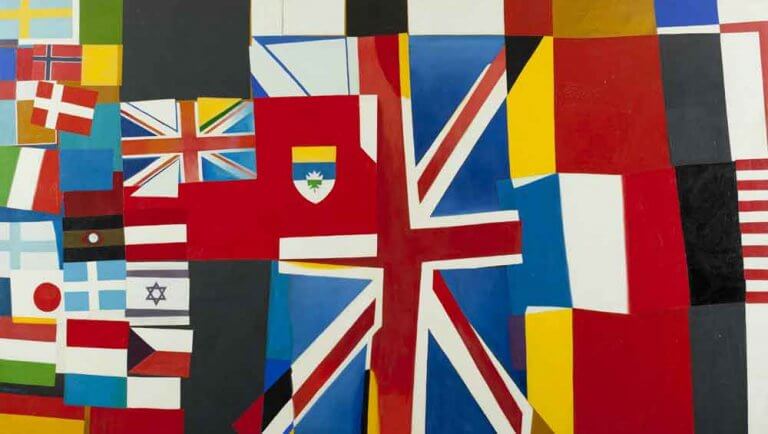
Jack Shadbolt’s 1964 Flag Mural and the Canadian Flag Debate


Vancouver-based artist, Jack Shadbolt (1909-1998), was commissioned to paint Flag Mural for the opening of the Confederation Centre of the Arts in 1964. His two sketches for this painting use geometric flag motifs with a Red Ensign on left, a Union Flag of the United Kingdom at center and the French Tricolour at right as does the final composition. Shadbolt’s Flag Mural arrived in Charlottetown in May of 1964 while Canadians were still embroiled in a vigorous national debate about a new Canadian flag. His consideration of the Canadian federation at that moment of reflection and transition with its 1967 centennial in sight, provided the starting point and subject for his mural. Shadbolt wrote, “What have we come to since Confederation? What are we now? What would symbolize us?” These questions are still implied in Flag Mural, and remain every bit as relevant for today’s consideration of the painting and Shadbolt’s particular concerns about multiculturalism and multilateralism which he alludes to in his statement on Flag Mural. “With the arrival of so many ethnic groups and with our steady emergence into the international world, the image of Canada as primarily an English-French one with a commonwealth flavor and an Indian-Eskimo overtone is undergoing a fundamental transformation. New colors, new stripes are added, old patterns shift and change.”
On forming a government in 1963, Prime Minister Lester B. Pearson acted on his promise of a distinctive new flag for Canada and it led to the submission of thousands of flag designs, including the small sampling in this exhibition, and months of partisan and polarizing debate. It seems the debate was so heated that Flag Mural was not exhibited for the Prime Minister’s visit to the Confederation Centre in the fall of 1964 for fear it would offend him. In December 1964, parliament voted in favor of a new flag for Canada. The red maple leaf on a white ground flanked by red, known as the National Flag of Canada or the Maple Leaf Flag, was inaugurated on February 15, 1965.
For a viewer wondering why today’s Canadian flag is not included in Jack Shadbolt’s Flag Mural, 1964, it is easy to say the mural pre-dated the Maple Leaf flag. But for the viewer wondering how our reading of the mural anticipated and reflected transformation in Canadian society, it is worth noting the 1960s saw some fundamental public policy developments including a Royal Commission on Bilingualism and Biculturalism (1963); the Canada Pension Plan Act (1965); Medical Care Act (1966); the establishment of the Order of Canada (1967); the Official Languages Act (1969); and the successful hosting of a world fair, Expo 67, to celebrate Canada’s centennial.
Kevin Rice, Director